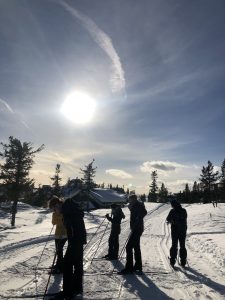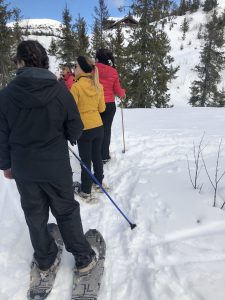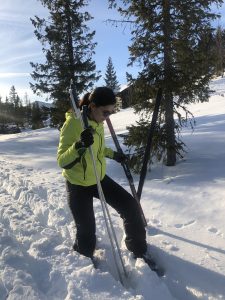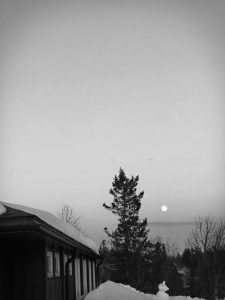Winter activities and Nordic skiing, Jønnbu, 2019
Our winter excursion started on March 20thand has finished on March 21st. For me, it was the first time when I tried cross-country skiing.
Our trip started early in the morning, and our activities right after we arrived in Telemark. On the first day there we focused more on learning how to ski. After arriving in Jønnbu, we received our skis and our boots and the first thing that we did furthermore, was to wax them and put them on. In the beginning I was a bit concerned about the fact that I have never tried ski before, just snowboarding. I said to myself that it is going to be much more easier to ski than to do snowboarding because you can use the equilibrium of your whole body, by using your both legs in order to control the skis. And I was mostly right, except the fact that I couldn’t stop on them even if I tried a lot; it was very hard for me and a little bit frustrating to go into plough with the skis because they were very narrowed and hard to control and you could have catch a higher speed on them in a very short time. So, I came with the easiest solution in order to stop and don’t give up just because of this reason. My solution was to throw myself on the ground, and it worked a bit until I felt really bad and I had to stop myself from skiing because I couldn’t walk and the end of the day. Beside this, after arriving in Jønnbu, we received some good instructions about how we should stay on skiis, how should we get up from them, and many other useful things. Afterwards, we did some exercises on skis, in order to practice more for the hike that we did in the afternoon. The exercises were solicitant but really helpful. We had to run on the skis, play, and some other games that were beneficial for developing the motor-skills. Later on, we did a campfire and ate our meal.
The next activity that we undertook was building the snow blocks in five teams and sculpt them afterwards. Our team chose to build a weasel (Annex 1)and a pine tree, things that are very specific for the wildlife in Telemark. When it comes to the teamwork during this exercise, I can say that it was such a good experience sharing the same ideas and creating something 3D that could have become something without sense if we wouldn’t collaborate like a real team. Before building the sculptures we had a good plan of how each of us should contribute to it so it will have a coherent shape. After finishing the sculptures, we went skiing again (Annex 2),this time going downhill. It was very fun and the weather and the landscape were amazing. Beside the fact that I still couldn’t go into plough so I could stop everything went perfect. I really like the teamwork in this hike too. We were divided in the same groups as building the sculptures, and we had to wait for the ones that were a little bit afraid of going downhill. Again everything was really good and we encouraged each other and push our limits so we could continue the hike. The ones that wanted to stay and practice more stayed and the others that wanted to go downhill went a bit more far away in the nature. After coming back home, we had the international dinner. The dinner was amazing, each of us contribute a lot and put a lot of effort and soul into making the food (Annex 3).We had dishes from China, Germany, Spain, Sweeden, Norway, Romania and Irish food.
The second day started with a breakfast with all the classmates, and after that we learned how to do orientation in the mountains with a compass, and a map. We made our own bread dough after and we left in a small hike to do some activities. Our team had to wear ski shoes (Annex 4)because I couldn’t move my leg due to an accident while skiing. The activities were about the wildlife in the area, about the animals, what are they eating and so on, other group learned how to build a professional tent and another group learned how to build some blocks in case of avalanches (the groups changed the activities between them). After that we went back and we baked our own bread (Annex 5).Afterwards, we had the opportunity to choose between cross-country skiing, sliding or going on snowshoes. I had to choose sliding because my leg was hurting, even if I wanted to choose cross-country skiing.
Overall, the ski trip was really amazing. It made me realized that even if I am here for just two months I know my colleagues really good already and the collaboration between us was very strong, especially while doing the teamwork exercises. I think that this trip was very helpful in order to know my colleagues better and to improve my team working skills. This excursion also made me push my limits so I could learn how to ski faster in order to enjoy the experience more, but due to the fact that my leg was hurting, I had to stop skiing the second day. In my home country, Romania, there are not so many people doing cross-country ski, mostly all of the people are doing slalom or snowboarding. In conclusion, for me, it was a really good experience and I am sure that I will repeat it when I will have the occasion, and I will recommend to other people to try it. Even if it was hard, it worth every single fall.
Part II- Outdoor winter activities with Romanian children
As is is stated in Fjørtoft, Ingunn, (2004) study, outdoor playgrounds are designed to facilitate children’s play and are intended to enhance their physical, social, emotional and cognitive development (Hart 1993). In Romania, taking children in an outdoor place, it’s a complex process, because in order to take them in a place like Jønnbu, you need a lot of approvals from the parents, cityhall, school and so on. If I would have the opportunity to go in this place with a group of children, I would have choose a smaller group, like the group of our Outdoor class, meaning 15 people, because it’s easier to pay attention to all of them. I would have chose children around 9-12 years old because as some studies says when it comes to they gross motor or motor-skills, they show increased body awareness and self-perception and also they have an increased awareness of their own physical skills. (Child Development Network, 2003).
In order to undertake the activities with the children, firstly we should be aware before going out, about the weather condition in the area, and pay attention and took into consideration the Mountain code in Norway in order to provide a safety environment for everyone. Which has the main following concepts: plan your trip based on the group’s abilities, and always include alternative options, obtain current information about the area and the weather conditions, always check the weather forecast and avalanche warnings to see what impact they have on the area, follow the advice and choose a gentler terrain when conditions are too demanding, dress appropriately for the weather, bring the necessary equipment so you can help yourself and others, avoid terrain that is prone to avalanches, and plan your route well.
When it comes to the activities that I would have do with the children I would have use the affordances that the nature is providing to us in order to improve during this excursion the children’s motor development, as Fjørtoft (2004) is stating in his study “Landscape as Playscape: The Effects of Natural Environments on Children’s Play and Motor Development “a forest, seashore, creek, or mountain area, represents a dynamic environment and a stimulating and challenging playground for child”.
All the activities will imply snow as the main theme. The activities are going to be more or less the same as we did, lots of body movement and playing in the snow because as Schwartzman is stating in one of his papers that biologically, play has an important role in the development of a child, by improving his cognitive development. So the main activities that I wanted to do with the 9-12 years old kids are cross-country skiing because they will help children develop more their motor skills by doing different risky play activities. When it comes to risky play, this does not necessarily mean putting a child into danger in order to hurt him but means providing a child the opportunities to use the outside surroundings in order to challenge him. Moreover, in my opinion risky play might be used as a coping strategy for overcoming different fears. Risky play as studies are showing has multiple benefits in the development of a child, for example motivating them that if they fail, they should try again, enhance the motor skills, and most important enhance the body awareness.
Building sculptures in the snow is another activity that I propose to do with the pupils. This activity was one of the best that I have did so far because it has improved my team working skills and for sure it will work for children in that age group in order to improve their creativity and team working skills.
The activities for developing the survival skills for the pupils would be another good activity that I would undertake it with the children because in this way they will learn about what they should do in case of avalanche, and the essential things that they can do on mountain while hiking: building a tent and so on.
A campfire and making their own ice cream is a very nice activity to do with the children with this group age also. Other activities like sliding on the snow, cooking the dinner with the children, chopping our own silverware in order to eat the ice cream and our meals at the camp fire would be approached.
As regards to the knowledge of the pupils, my expectation after this excursion is to raise the awareness of the children when it comes to the risky play and survival skills on the mountain during winter, improve their abilities to do cross-country skiing, improve their team-working skills, and their creativity through activities like building sculptures in the snow or chopping wood.

